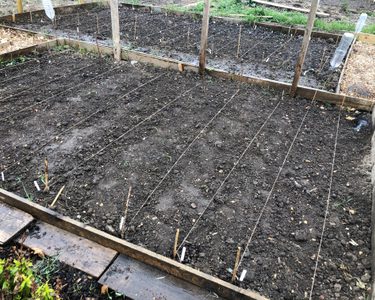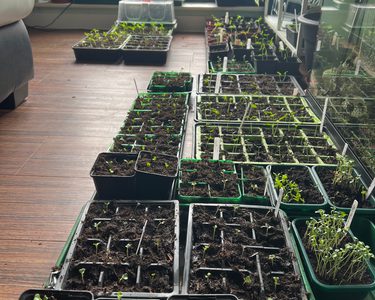Chris Collins on… sowing drills outdoors

April is a month on the cusp of the fresh growing season, with seeds being sown and seedlings getting established. I would probably put this month as one of the busiest of the year for a gardener.
My living room has become fuller by the day, with many seedlings now pricked out and producing their first true leaves. I’m in awe of my seedling friends, particularly their ability to transition from seed to plant when the conditions are favourable. They will give me so much pleasure in the coming months.
But it’s to the allotment that my attention turns this month as it’s time to start open-ground drill sowing. I’ll start with separate areas, first for drill sowing of salad and quick-growing crops like radish. Then, a second space for root crops and a third for brassicas. Finally, each of these areas will have a small section spliced off for sowing hardy annuals.
Sowing the seeds of success outdoors
Terms such as ‘drill’, ‘station’ and ‘thinning’ are all descriptions of actions related to the direct sowing of seeds in open ground. And I appreciate that to the gardener just setting out on their growing journey, these terms might feel like a different language, so here’s my step-by-step:
Step one
Give the area you are sowing a light fork over. My soil had compost added at the beginning of March and quite a lot has already been pulled in by the worms. Traditionally, compost would have been dug-in but now I prefer to leave this ‘incorporation’ to nature. Next, I’ll run the rake over it, walk over it with the back of my heels, re-rake and put down a garden line where my seeds are to be sown. Two jobs are achieved with these actions: my soil is now consolidated and has a fine texture, perfect for seeds. Secondly, the line will ensure that upon germination I’ll be able to identify the emerging seed, rather than the scatter gun nature of emerging wild seed that will appear around them.
Step two
I now make a ‘drill’ using a dibber (or a thin stick of wood will suffice). This drill is a shallow trench carved out along the side of the garden line. The depth is dictated by the size of the seed. For example, a spinach seed is roughly 2mm in diameter so it will require a trench of 6mm, approximately two thirds its size. Once the drill is made, the seeds are dropped in at ‘stations’ this is the preferred distance between the plants once they mature. A lot of gardeners like to sow stations a bit closer than recommended on the seed packet and ‘thin’ out the seedlings as the grow, this means removing excess seedlings to get the required spacing. Don't worry, many of these thinned seedlings can go into a salad, so no waste!
Step three
Finally, we have three little tasks once the seedlings are in place. Sieve some soil over the top of the seedlings and gently firm and label your seedlings. Then, take a watering can with a rose and turn the rose upwards and pour over the drill. This produces a fine spray of water, gives a good soaking but prevents any washing out of your lovingly sown seeds.
If you are concerned about depths and distances of your seeds, the packet will always give you a good guide. I always like to leave extra distance between each of my drills, allowing me to inter-sow fresh drills, particularly with faster growing crops like salad leaves and rocket, thus giving me a constant, regular supply.

Parsnips and pollinators
This initial drill-sowing operation can last two or three days at my allotment – and the only exception to this rule is my parsnip seed. I find if I sow these seeds straight into drills I have mixed, patchy germination. So, I’ve taken to sowing them in toilet rolls (empty rolls that is) and my germination rate is a lot higher. Once the seedlings appear, I can just sink the roll in-situ on the allotment. You’ll be glad to hear that there never seems to be a shortage of empty toilet rolls in the average family house so it's a good ‘upcycling’ in my book!
I’ll also leave room for hardy-annual drills in a 50cm band along the edge of my food crops. These are grown to provide food for pollinators, encourage biodiversity and light up the allotment with colour throughout the summer.
I do my spring sowing in three waves and although I’ll repeat sow throughout the summer, the third and final spring wave will happen next month when I begin the tender crops such as squash, runner beans and courgettes.
Read more on this later - and happy gardening!
